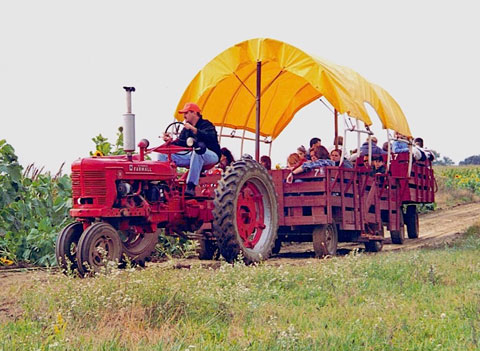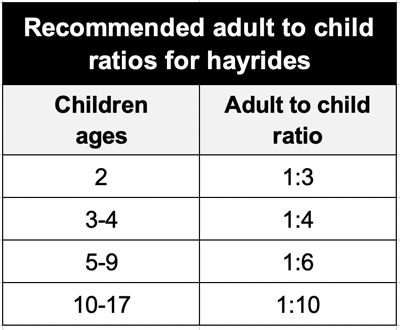
Vol. XIX, No. 7, August 2019
- Editor's corner
- Attention spans are shortening; trends don't last as long
- The evolution of the FEC industry - over expansion and opportunity
- Big investment in immersive mixed-use entertainment by Kevin Williams
- The cannibals are eating the CLV industry
- Essentials of hayride safety
- Is the obsession with beer justified?
- Review of Bar K - a multispecies social eatertainment venue by Linda Beckring
- The importance of great restaurant ambiance
- Do you know your cost of goods sold percentage?
- Jim Kessler gives it to us straight
- Cathedral-tainment
- Home is the new hangout
- Out-of-home entertainment & arts spending by occupation
- Randy's travel tips
Essentials of hayride safety
Hayrides are a popular and enjoyable attraction for visitors at agritainment/agritourism farms as well as at many other entertainment facilities such as family entertainment centers and parks in the Fall. However, hay wagon rides can be extremely dangerous if not operated safely. Our research shows that since the year 2000, hayride accidents have caused 167 injuries and the death of at least 22 people including 14 children.

Over our company's 25 years of agritourism/agritainment consulting and design work, we have visited very few existing farm operations that were safely operating their hayrides. We have always made it our first priority to advise our clients on needed improvements to make their hayrides safe. And fortunately, most followed our advice, making a visit to their farms much safer.
Here's a summary of essential safety procedures every farm or venue that operates a hayride should follow:
- The hayride route should have non-climbable barricade-type fencing along its route wherever it is in or near areas where visitors will be so there is no possibility of anyone, especially children, wandering into the path of the hayride. At the loading and unloading areas, the fencing should have gates that are operated only by the loading/unloading staff. The hayride path should NEVER cross or travel through any areas that the public has access to.
- The loading area should have a sign stating the safety rules for passengers.
- Separate unloading and loading areas. To speed loading, the loading area can have a corral fenced area where the number of visitors the wagon ride can hold are pre-counted into.

- The hayride trail should be kept smooth as depressions and ruts can cause wagons to grab hold and jerk, bouncing guests around. All trees and bushes along the trail need to be trimmed so riders won't be hit by branches.
- Tractors and hay wagons should be thoroughly inspected at the beginning of each day. There should be written inspection check list where the drivers check off each item and sign and date the sheet. This helps assure the procedures will be properly followed.
- All wagons must have a safety chain connecting the wagon's front axle to the tractor's draw bar or rear axle.
- For adequate traction and braking, the tractor pulling the hayride must weigh more than the gross weight of the wagon it pulls when full of people.
- The hay wagon must have railings and seating. Enclosure railings should be designed to prevent children from crawling through or climbing the railings. The front railing must be adequately tall and sturdy to prevent anyone from falling forward out of the wagon and being run over. The loading opening on the wagon should have a gate or enclosure that is kept shut other than when loading or unloading.
- Training is essential for all staff involved. All tractor drivers should be trained in the operation of the tractor they will be driving, including how to properly start and stop smoothly. Just because an employee knows how to drive a tractor does not mean they understand how to drive a hay wagon ride. All employees who will be responsible for loading, unloading and supervising hayrides must also be trained. There should be a pocket size checklist of all procedures that each staff member keeps with them.
- All wagons should have a tour guide riding in the wagon who has two-way radio communicate with the tractor driver. Tractor noise prevents a driver from hearing anything shouted from the wagon if there is a problem.
- Tractors should have rear view mirrors that give a full view of the wagon.
- There should be well-organized loading and unloading procedures.
- Only after the tractor comes to a stop in the unloading area, is put in neutral and the brake engaged, should the unloading staff open the wagon gate and assist people off.
- Once a wagon is unloaded, the unloading staff should close the barricade exiting gate, the wagon should be inspected for lost items, the tire inflation on the wagons and tractor eyeballed, the area around and under the wagon inspected to make sure there are no people or children, and only then should the tractor driver be signaled to proceed to the loading area.
- The barricade gate at the loading area should not be opened until the tractor is at a full stop, put in neutral and the brakes engaged.
- Once the wagon is loaded, the barricade loading gate should be closed, the wagon gate should be closed, safety instructions recited to the riders, riders checked to make sure all are seated, the area around and under the wagon inspected to make sure there are no people or children, the pins and safety chains on the wagons checked and only then should the tractor driver be signaled to proceed.
- Ideally communication between the loading and unloading staff and the driver should be via two-way radio communication. Otherwise, the driver's go-signal should be one that is visual, crystal clear and not mistakable.
- Public road travel should be avoided. If absolutely necessary, there should be escort vehicles with proper safety lighting at the lead and following the wagon. In 1989 in New Brunswick, Canada, 13 wagon riders died and 45 were injured when a logging trailer crashed into a hayride. In 2016 in Chucky, Mississippi, three people were killed when a pickup truck rear-ended a hay wagon traveling on a public road.
- Due to the hazardous nature of hayrides, children's field trip hayrides should have higher adult to child ratios than for the classroom. The following are recommended:

Hayrides are a great fun attraction for visitors. Just make sure you take the time and effort to operate yours safely.
Randy White is the CEO of the Kansas City, MO-based White Hutchinson Leisure & Learning Group consulting and design firm that works with all types of agritourism and agritainment farms. Randy was been working with agritourism/agritainment farms for over 25 years. Randy can be reached randy@whitehutchinson.com or at 816.931-1040, ext. 100.
Vol. XIX, No. 7, August 2019
- Editor's corner
- Attention spans are shortening; trends don't last as long
- The evolution of the FEC industry - over expansion and opportunity
- Big investment in immersive mixed-use entertainment by Kevin Williams
- The cannibals are eating the CLV industry
- Essentials of hayride safety
- Is the obsession with beer justified?
- Review of Bar K - a multispecies social eatertainment venue by Linda Beckring
- The importance of great restaurant ambiance
- Do you know your cost of goods sold percentage?
- Jim Kessler gives it to us straight
- Cathedral-tainment
- Home is the new hangout
- Out-of-home entertainment & arts spending by occupation
- Randy's travel tips


